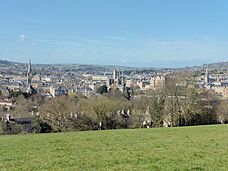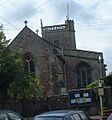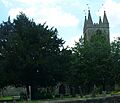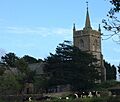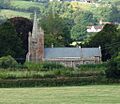Bath and North East Somerset facts for kids
Quick facts for kids
Bath and North East Somerset
|
||
|---|---|---|
|
Unitary authority area
|
||
|
||
|
||
| Nickname(s):
BANES or B&NES
|
||
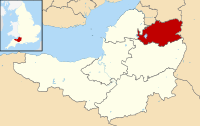
Bath and North East Somerset shown within Somerset
|
||
| Sovereign state | United Kingdom | |
| Constituent country | England | |
| Region | South West England | |
| Ceremonial county | Somerset | |
| Combined authority | West of England | |
| Admin HQ | Bath and Keynsham | |
| Created | 1 April 1996 | |
| Government | ||
| • Type | unitary authority | |
| Area | ||
| • Total | 135.57 sq mi (351.12 km2) | |
| • Land | 133.5 sq mi (345.7 km2) | |
| • Water | 2.02 sq mi (5.24 km2) | |
| Area rank | 122nd | |
| Population
(2005 est.)
|
||
| • Total | 193,282 (Ranked 97th) | |
| • Density | 1,340/sq mi (518/km2) | |
| Ethnicity (2021) | ||
| • Ethnic groups |
List
|
|
| Religion (2021) | ||
| • Religion |
List
47.9% no religion
42.2% Christianity 8.9% other 1% Islam |
|
| Time zone | UTC0 (GMT) | |
| • Summer (DST) | UTC+1 (BST) | |
| Postcode |
BA and BS
|
|
| Area codes | 01225 and others | |
| ISO 3166 code | GB-BAS | |
| ONS code | 00HA (ONS) E06000022 (GSS) |
|
Bath and North East Somerset (often called B&NES) is a special local government area in Somerset, South West England. It's known as a unitary authority because it handles almost all local services for its residents. The area was created on April 1, 1996, after the old county of Avon was removed. It's now part of the larger ceremonial county of Somerset.
The local council, Bath and North East Somerset Council, manages many important things for the community. This includes looking after roads, managing council housing, keeping the environment healthy, and handling rubbish collection and recycling. They also take care of parks, libraries, and tourism. Education and social services are also their responsibility. However, emergency services like fire, police, and ambulance are shared with other nearby areas. The main offices for the council are in Bath and Keynsham.
B&NES covers about 351 square kilometers (136 square miles). A big part of this land is protected as "green belt" to stop cities from growing too much. The area stretches from the edge of Bristol down to the Mendip Hills and across to the Cotswold Hills and the Wiltshire border. The biggest town is Bath, but B&NES also includes places like Keynsham, Midsomer Norton, Radstock, Westfield, Saltford, and the Chew Valley.
This region has a long and interesting history. People have lived here for thousands of years, and it played a big role in Roman times, the Saxon era, and the English Civil War. The area used to be mostly farms, but then coal mining became important, especially with the building of canals and railways. Bath became famous as a spa town in the Georgian period because of its natural hot springs. Today, Bath is a major tourist spot and is recognized as a World Heritage City.
Contents
History of the Bath Area
The area of Bath and North East Somerset has been home to people for thousands of years. Ancient sites like the Stanton Drew stone circles and the Stoney Littleton Long Barrow show that people lived here during the Neolithic (New Stone Age) period. Solsbury Hill has an Iron Age hill fort, which was a fortified settlement.
Roman Times and Hot Springs

The famous hot springs in Bath were first used as a special shrine by the Celts, who worshipped the goddess Sulis. When the Romans arrived, they connected Sulis with their goddess Minerva. They named the town Aquae Sulis, which means "the waters of Sulis." The Romans built impressive baths and a temple around these springs.
Archaeologists have also found Roman remains in other parts of the area, like a large villa at Chew Park and another at Keynsham. These show that farming and other activities were happening here from the first to the third centuries AD.
Saxon Era and Early Kings
After the Romans left, there were battles between the native British people and the Saxons. This area became a borderland. The Wansdyke, a large ditch and bank, was likely built around the 5th or 6th century as a defense.
In 675 AD, King Osric of the Hwicce started a monastery in Bath. Later, King Offa rebuilt the church. King Alfred helped plan the town again, and in 973, Edgar of England was crowned king of England in Bath Abbey.
Medieval Times and New Buildings

In 1088, the city of Bath was given to a royal doctor, John of Tours, who became a bishop. He started building a much bigger church, which became his cathedral. New baths were also built around the springs.
By the 15th century, Bath's abbey church was falling apart. Bishop Oliver King decided to rebuild it in 1500. The new church was finished just before Henry VIII closed down monasteries in 1539. The abbey church was later fixed up and became the city's main church. Bath became a city by Royal Charter from Queen Elizabeth I in 1590.
Keynsham also grew into a market town in medieval times, thanks to a rich abbey founded around 1170.
From the 17th Century to Today
During the English Civil War in the 1640s, a battle was fought near Bath in 1643.
In the late 1600s, a doctor named Thomas Guidott became interested in the healing powers of Bath's hot waters. He wrote a book about them, which made the city very popular with rich people. This led to a lot of building in the 1700s, especially during the Georgian era. Architects like John Wood the elder and his son John Wood the younger designed the famous streets and squares, like the Royal Crescent and The Circus. These buildings were made from local Bath stone, giving the city its unique golden look.
In the north of Somerset, around Radstock, coal mining was a big industry. To move the coal, the Somerset Coal Canal was built. Parts of it later became a railway. This canal connected to the Kennet and Avon Canal, which linked the River Thames to Bristol. The Somerset and Dorset Joint Railway also connected Bath to Bournemouth.
During World War II, in April 1942, Bath was bombed by German planes. Many buildings were damaged or destroyed, but famous places like the Royal Crescent and The Circus have since been rebuilt.
In 1968, the River Chew had a big flood, causing damage to towns and villages in the Chew Valley.
Geography and Landscape
Bath and North East Somerset covers about 351 square kilometers (136 square miles). Most of this land is protected as green belt. The area stretches from the edge of Bristol south into the Mendip Hills and east towards the Cotswold Hills and Wiltshire. Neighboring areas include Bristol, North Somerset, Somerset, South Gloucestershire, and Wiltshire.
The main city in the district is Bath. Other important towns and villages include Keynsham, Midsomer Norton, Radstock, and the Chew Valley. The River Avon flows through Bath, along with smaller rivers like the River Chew.
The Chew Valley
In the western part of B&NES, the Chew Valley is mostly low and rolling hills. It's surrounded by higher ground like Dundry Down and the Mendip Hills. In the 1950s, the River Chew was dammed to create Chew Valley Lake. This lake provides drinking water for Bristol and is a popular spot for outdoor activities. It's also very important for nature conservation because of its many birds, plants, and insects.
North of Bath, you'll find hills like Lansdown and Solsbury Hill. These are part of the Cotswolds.
How Bath and North East Somerset is Governed
Bath and North East Somerset (B&NES) is a unitary authority. This means it has one main council that handles most local government jobs. Before 1996, Bath was part of a larger county called Avon. When Avon was dissolved, B&NES was created.
The B&NES Council is made up of 59 councillors. These councillors are elected by the people living in different parts of the district. The council makes decisions about local services, planning, and how the area is run.
Council Elections and Leadership
For many years, no single political party had full control of the B&NES Council. The Liberal Democrats were often the strongest party. In 2015, the Conservative Party won a majority of seats for the first time. However, in 2019 and 2023, the Liberal Democrats won back control and now have the most seats.
After the May 2023 election, the council seats are divided like this:
- Liberal Democrats: 41 seats
- Labour Party: 5 seats
- Independent councillors: 5 seats
- Conservative Party: 3 seats
- Green Party: 3 seats
The leader of the council is Kevin Guy.
Local Towns and Villages
The city of Bath itself is not divided into smaller parishes. However, many other towns and villages in the B&NES area have their own local councils called civil parishes. These parishes help manage very local issues.
Here are some of the civil parishes and towns in the area:
- Bathampton
- Batheaston
- Bathford
- Cameley
- Camerton
- Charlcombe
- Chelwood
- Chew Magna
- Chew Stoke
- Claverton
- Clutton
- Combe Hay
- Compton Dando
- Compton Martin
- Corston
- Dunkerton
- East Harptree
- Englishcombe
- Farmborough
- Farrington Gurney
- Freshford
- High Littleton
- Hinton Blewett
- Hinton Charterhouse
- Kelston
- Keynsham (a town)
- Marksbury
- Midsomer Norton (a town)
- Monkton Combe
- Nempnett Thrubwell
- Newton St Loe
- Norton Malreward
- Paulton
- Peasedown St John
- Priston
- Publow
- Radstock (a town)
- Saltford
- Shoscombe
- Southstoke
- Stanton Drew
- Stowey-Sutton
- Swainswick
- Timsbury
- Ubley
- Wellow
- Westfield
- West Harptree
- Whitchurch
Population and People
About 170,238 people live in Bath and North East Somerset. Roughly half of them live in the city of Bath, which is much more crowded than the rest of the area.
According to the 2021 census, most people in the district are from a white ethnic background (92.2%). Other groups include Asian (3.3%), Mixed (2.7%), and Black (1%).
When it comes to religion, about 47.9% of people say they have no religion. Christianity is the next largest group at 42.2%.
The area is generally healthy. Fewer people report being "not healthy" or having a long-term illness compared to the national average.
Economy and Jobs
The economy of Bath and North East Somerset has changed over the years. It used to be very focused on farming and industry (like coal mining). Now, the "services" sector, which includes things like tourism, education, and healthcare, is the biggest part of the economy.
Here's a simple look at how the economy grew:
- In 1995, the total value of goods and services produced was about £5.9 billion.
- By 2003, it had grown to about £10.8 billion.
- Services make up the largest part of this value.
Getting Around: Transport
Bath is about 19 kilometers (12 miles) southeast of Bristol, a larger city and port. They are connected by the A4 road. The M4 motorway is also nearby. Other important roads include the A37 and A368.
Waterways and Cycling
The River Avon connects Bath to Bristol and the sea. Small boats can travel on it using locks. The river is also linked to the River Thames and London by the Kennet & Avon Canal. This canal was closed for many years but has been restored and is now popular with narrow boat users.
Bath is part of National Cycle Route 4. One of Britain's first cycleways, the Bristol & Bath Railway Path, runs to the west. You can also cycle east towards London along the canal towpath.
Trains and Airports
Bath Spa railway station is the main train station in Bath. It was designed by the famous engineer Isambard Kingdom Brunel. From here, you can catch trains to:
- London Paddington
- Bristol Temple Meads
- Cardiff Central
- Exeter St Davids
- Other towns like Salisbury and Brighton
There are also smaller local stations at Oldfield Park and Keynsham.
While Bath doesn't have its own airport, Bristol Airport is only about 29 kilometers (18 miles) away. You can get there by road or by train to Bristol Temple Meads station.
Media and Local News
The area gets its TV news from BBC West and ITV West Country.
There are several local radio stations:
- BBC Radio Bristol (94.9 FM, 103.6 FM, 104.6 FM)
- BBC Radio Somerset (95.5 FM)
- Heart West (96.3 FM, 102.6 FM, 103.0 FM)
- Greatest Hits Radio Bath & The South West (107.9 FM)
- Greatest Hits Radio Bristol & The South West (107.2 FM)
- Hits Radio Bristol and Bath (106.5 FM)
- Somer Valley FM (97.5 FM) – this one serves Midsomer Norton, Radstock, and Westfield.
Education in B&NES
Bath and North East Somerset has many schools. The local council manages state-funded schools in the district.
Schools and Colleges
The city has one further education college, Bath College, where students can continue their studies after school. Many schools also have sixth forms for older students. In 2006, about 52% of students in B&NES achieved good grades (5 A-C grades including English and Maths) in their GCSE exams, which was higher than the national average. For students with special needs, there is Three Ways School.
Universities in Bath
Bath is home to two universities:
- The University of Bath was founded in 1966. It's well-known for subjects like science, math, architecture, and technology.
- Bath Spa University became a university in 2005. It specializes in arts, design, education, English, history, music, and social sciences.
Sports and Activities
Sports are a big part of life in Bath and North East Somerset.
- Bath Rugby is a famous rugby team that plays at the Recreation Ground.
- Bath Cricket Club plays cricket next door at the North Parade ground.
- For football fans, Bath City F.C. is the main team in Bath. There are also clubs in nearby areas like Paulton Rovers F. C., Bishop Sutton A.F.C., Radstock Town F.C., and Welton Rovers F.C..
The Bath Half Marathon is a popular running race held every year, with over 10,000 runners. Cycling is also very popular, with places like Royal Victoria Park and special trails for biking.
There are sports and leisure centers in Bath, Keynsham, the Chew Valley, and Midsomer Norton. The countryside is great for walking, and both Chew Valley Lake and Blagdon Lake are popular for fishing. Chew Valley Sailing Club offers sailing activities on Chew Valley Lake.
Interesting Places to Visit
The area has many historic buildings and places of interest. There are over 72,000 homes in B&NES, and more than 6,400 of them are listed buildings. This means they are protected because of their historical or architectural importance. Many of these are in Bath, like the famous Lansdown Crescent, the Royal Crescent, The Circus, and Pulteney Bridge. Outside the city, you can find historic manor houses like St Catherine's Court.
Bath is a major tourist destination with lots of museums and art galleries. Some popular ones include:
- The Victoria Art Gallery
- The Museum of East Asian Art
- The Holburne Museum of Art
- The Bath Postal Museum
- The Fashion Museum
- The Jane Austen Centre
- The Herschel Museum of Astronomy
- The amazing Roman Baths
Outside Bath, the Radstock Museum tells the story of the local coal mining history.
For train enthusiasts, the Avon Valley Railway and the Somerset & Dorset Railway Heritage Trust at Midsomer Norton railway station offer a glimpse into the past of railways.
Images for kids
-
High Street in Keynsham.
-
A view of Midsomer Norton.
-
The mine wheel in Radstock.
-
The church in Whitchurch.
See also
 In Spanish: Bath y noreste de Somerset para niños
In Spanish: Bath y noreste de Somerset para niños


